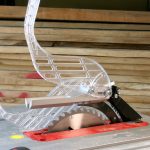We may receive a commission when you use our affiliate links. However, this does not impact our recommendations.
I have intended for 14 months to add handles to the chest I built for “The Anarchist’s Tool Chest.” And in fact, I had a pair of cool iron chest lifts that a kind reader sent me.
But life and other projects kept getting in the way of making the gaping mortises for these cool iron flush lifts, which are shown in the book. A tool chest that lacks handles is like manhandling an oily seal into a wetsuit.
I think we’ve all been there. You don’t know where to grab it and it keeps slipping. So when Roy Underhill had to help me pull my tool chest out of my Honda a few weeks ago I could hear a “tsk tsk” behind that awesome mustache of his.
But instead of just giving me a rash of grief about it, Roy made oak handles for my chest. These handles are copies of handles attached to a 19th-century chest that Roy owns – it’s one of his blue ones that all the wack-nutty dovetailing.
The process of making these handles is pretty cool. The handles begin as a chunk of oak 1-1/2” x 1-7/8” x 13-1/4”. You turn the center 4-1/4” section down to a grip that is 1-1/4” in diameter. Then each end is shaped to an ogee. The handle is screwed to the chest, both from inside the chest and out.
The cool part of the handle is turning the center part, which is offset to the front of the handle. To do this, you have to scab on some extra blocks to the handle blank to keep the turning balanced.
If these words make your brain hurt, then watch this short video that explains it.
Roy, in true Woodwright’s Shop fashion, enlisted the students in my tool chest class to help turn one of the handles. So to me the handle is even cooler than one made just by Roy.
Roy gave me the handles as I was packing up to leave his school with an imminent thunderstorm approaching, so we didn’t have time to install them at the school. The handles have languished at the bottom of my chest for a couple weeks now.
But Saturday morning I woke up with a start at 6 a.m. I had to talk to the Cincinnati Woodworker’s club that morning and had no way – none – lined up to get the chest in the car. I knew that I would have to enlist the help of my wife, Lucy, to lift the behemoth out of the basement and into her car.
And then Lucy would call the divorce lawyer.
The addition of the handles might just be enough to keep us out of the court system, I thought. So I quickly dressed up the handles with a rasp and plane and attached them to the chest using slotted screws left over from my grandfather’s hardware stash.
I managed to get the handles on, and Lucy and I somehow wrangled the chest into her trunk. The handles definitely helped save the day – and my marriage. Taking her out to dinner and a play Saturday night didn’t hurt, either.
— Christopher Schwarz
The tool chest is the object featured in “The Anarchist’s Tool Chest,” which I wrote last year after researching more than 50 tool chests. You can buy the book with free domestic shipping at ShopWoodworking.com.
Here are some supplies and tools we find essential in our everyday work around the shop. We may receive a commission from sales referred by our links; however, we have carefully selected these products for their usefulness and quality.












Wait. What?!!
Attaching the bottom with nails certainly raised my eyebrows, but after I read your explanation I saw the sense of it.
But just using *SCREWS* to attach the handles onto your through-dovetailed, survive-for-generations chest?
Somehow I can’t believe I read that right. (Schwarz wrote that? Really?!!)
Seems like if there’s any part of the chest that needs to be over-engineered it’s the dang handles. Not even a little mortice, peg, or some sort of heavy-duty ironmongery? Geez. 🙂
Attaching the screws from both sides makes sense (and is a trick I’ve not considered before) but exactly how ginormous are those screws you used? A loaded tool chest must be pretty darn heavy! (Just bought the wood, but haven’t yet built mine.)
I’m curious about St. Roy’s view on eye protection. Magnificent eyebrows will divert some of the chips, but, but, but..
Coincidentally, I’ve fallen into the “Axe Men” series on the History Channel, and I’m equally surprised to see loggers galloping around down in the brush without eye protection. (At the beginning of Series 2, they indicated that 80 loggers had died at work the preceding year. Maybe if you need every bit of peripheral vision to just stay alive, chip-speckled goggles are more likely to get you squished. Only takes one little twig to poke yer eye aht, as they say around here.
“Avoidable risks”: don’t be a logger, don’t run a lathe sans specs?
These handles really suit the chest. Nice choice.
Hm, I don’t remember seeing the iron flush lifts in the book. But I do remember you weren’t keen on the usefulness of beckets, and by proxy (so I interpreted) handles in general. Changed your mind after moving the beast a few times?
I’m amused that some of the “related” videos are advertising various exercise machines. You should market The Anarchist’s Workout with a video of moving the chest in and out of the car over and over.
Speaking as one of the students you refer to, I am really proud to have played a (very small) part of making these handles. Thanks for a great class. And thanks to Roy for the opportunity to try out the lathe.
Very Nice!!
Can we assume that it was “Waiting for Godot”?